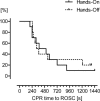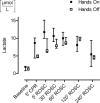Hands-on defibrillation has the potential to improve the quality of cardiopulmonary resuscitation and is safe for rescuers-a preclinical study
- PMID: 23316286
- PMCID: PMC3541629
- DOI: 10.1161/JAHA.112.001313
Hands-on defibrillation has the potential to improve the quality of cardiopulmonary resuscitation and is safe for rescuers-a preclinical study
Abstract
Background: Recently, it has been demonstrated that rescuers could safely provide a low, static downward force in direct contact with patients during elective cardioversion. The purpose of our experimental study was to investigate whether shock delivery during uninterrupted chest compressions may have an impact on cardiopulmonary resuscitation (CPR) quality and can be safely performed in a realistic animal model of CPR.
Methods and results: Twenty anesthetized swine were subjected to 7 minutes of ventricular fibrillation followed by CPR according to the 2010 American Heart Association Guidelines. Pregelled self-adhesive defibrillation electrodes were attached onto the torso in the ventrodorsal direction and connected to a biphasic defibrillator. Animals were randomized either to (1) hands-on defibrillation, where rescuers wore 2 pairs of polyethylene gloves and shocks were delivered during ongoing chest compressions, or (2) hands-off defibrillation, where hands were taken off during defibrillation. CPR was successful in 9 out of 10 animals in the hands-on group (versus 8 out of 10 animals in the hands-off group; not significant). In the hands-on group, chest compressions were interrupted for 0.8% [0.6%; 1.4%] of the total CPR time (versus 8.2% [4.2%; 9.0%]; P=0.0003), and coronary perfusion pressure was earlier restored to its pre-interruption level (P=0.0205). Also, rescuers neither sensed any kind of electric stimulus nor did Holter ECG reveal any serious cardiac arrhythmia.
Conclusions: Hands-on defibrillation may improve CPR quality and could be safely performed during uninterrupted chest compressions in our standardized porcine model.
Keywords: cardiac arrest; cardiopulmonary resuscitation; chest compression; defibrillation; resuscitation.
Figures






Comment in
-
Hands-On defibrillation-the end of "i'm clear, you're clear, we're all clear"?J Am Heart Assoc. 2012 Oct;1(5):e005496. doi: 10.1161/JAHA.112.005496. Epub 2012 Oct 25. J Am Heart Assoc. 2012. PMID: 23316308 Free PMC article. No abstract available.
-
Hands-on defibrillation: "Gloves as sweet as damask roses" (William Shakespeare: The winter's tale).Resuscitation. 2015 May;90:A6-7. doi: 10.1016/j.resuscitation.2015.02.029. Epub 2015 Mar 9. Resuscitation. 2015. PMID: 25769510 No abstract available.
References
-
- Yu T, Weil MH, Tang W, Sun S, Klouche K, Povoas H, Bisera J. Adverse outcomes of interrupted precordial compression during automated defibrillation. Circulation. 2002;106:368-372. - PubMed
-
- Berg RA, Hemphill R, Abella BS, Aufderheide TP, Cave DM, Hazinski MF, Lerner EB, Rea TD, Sayre MR, Swor RA. Part 5: Adult basic life support: 2010 American Heart Association Guidelines for cardiopulmonary resuscitation and emergency cardiovascular care. Circulation. 2010;122:S685-S705. - PubMed
-
- Sayre MR, Berg RA, Cave DM, Page RL, Potts J, White RD. Hands-only (compression-only) cardiopulmonary resuscitation: a call to action for bystander response to adults who experience out-of-hospital sudden cardiac arrest: a science advisory for the public from the American Heart Association Emergency Cardiovascular Care Committee. Circulation. 2008;117:2162-2167. - PubMed
-
- Hazinski MF, Nolan JP, Billi JE, Bottiger BW, Bossaert L, de Caen AR, Deakin CD, Drajer S, Eigel B, Hickey RW, Jacobs I, Kleinman ME, Kloeck W, Koster RW, Lim SH, Mancini ME, Montgomery WH, Morley PT, Morrison LJ, Nadkarni VM, O'Connor RE, Okada K, Perlman JM, Sayre MR, Shuster M, Soar J, Sunde K, Travers AH, Wyllie J, Zideman D. Part 1: Executive summary: 2010 International Consensus on cardiopulmonary resuscitation and emergency cardiovascular care science with treatment recommendations. Circulation. 2010;122:S250-S275. - PubMed
-
- Lloyd MS, Heeke B, Walter PF, Langberg JJ. Hands-on defibrillation: an analysis of electrical current flow through rescuers in direct contact with patients during biphasic external defibrillation. Circulation. 2008;117:2510-2514. - PubMed
Publication types
MeSH terms
LinkOut - more resources
Full Text Sources
Other Literature Sources
Medical

